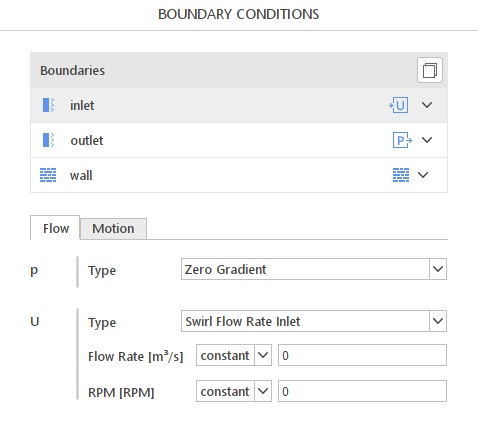Swirl Flow Rate Inlet - Boundary Condition Description
Swirl Flow Rate Inlet boundary condition prescribes inlet mass flow \(\dot{m}\) or volumetric flow \(\dot{Q}\), while still letting the User prescribe the swirl component determined by the angular speed, given in revolutions per minute.
The boundary condition is similar to Swirl Inlet. However, instead of prescribing all three velocity components (axial, radial and tangential), the axial velocity component results from the prescribed inlet flow rate.
That makes Swirl Flow Rate Inlet the natural choice when:
- the inlet fixes the through-put, not the axial velocity
- the flow is compressible and the density – hence axial speed – must adjust every time-step to adjust to the requested \(\dot{m}\).
Swirl Flow Rate Inlet - Boundary Condition Understanding Swirl Flow Rate Inlet
Mathematically, Swirl Flow Rate Inlet constructs the inlet velocity vector in the following way:
\(\vec U = U_z + U_{\phi} \)
where:
\(U_z\) - axial component,
\(U_{\phi}\) - tangential component.
Swirl Flow Rate Inlet is similar to Swirl Inlet, however, the key difference is the definition of axial velocity components.
The tangential component is calculated in the following way:
\(U_\Phi = \omega (\vec a \otimes (\vec x - \vec x_0))\),
where:
\(\vec a\) - unit-length vector in a tangential direction,
\(\omega\) - angular velocity [\({rad}/s\)].
The tangential velocity (\(U_{tangential}\)) component is taken directly from the User input, defined in revolutions per minute RPM:
\(\omega = RPM \cdot \frac{2\pi}{60}\)
In the next step, the uniform axial speed is computed to satisfy the flow-rate:
\(U_n = \frac{\dot{Q}}{A_{total}} \qquad\) or \(\qquad U_n = \frac{\dot{m}}{A_{total}}\)
Then combined swirl and axial parts are constructed, taking density into account if the flow is compressible:
- Volumetric flow
\(U = U_\Phi + \vec n U_n\)
- Mass-flow rate (compressible flow)
\(U = U_\Phi + \vec n \frac{U_n}{\rho}\)
Swirl Flow Rate Inlet - Boundary Condition Application & Physical Interpretation
Swirl Flow Rate Inlet describes an inflow naturally expressed by flow-rate, rather than the axial velocity. It is perfectly suited for CFD simulations of cyclone separators, swirl burners, annular sonic nozzles or rotating-mesh mixers. Especially for compressible flow, it is important to satisfy the mass-flow rate, which is not guaranteed when the velocity is prescribed (due to density variation).
Swirl Flow Rate Inlet in Gas-Turbine Combustor applications
Example applications: swirl-stabilised combustor
This problem can be addressed using the sprayFoam (solver) solver. While fully developed laminar flow in a pipe has a parabolic velocity profile, near the entrance, the profile is developing and not yet parabolic.
| Physics | Pressure | Velocity |
|---|---|---|
Inlet | Zero Gradient | Swirl Flow Rate Inlet |
Outlet (wind tunnel) | Fixed Value | Pressure Inlet-Outlet Velocity |
Swirl Flow Rate Inlet - Boundary Condition Swirl Flow Rate Inlet in SimFlow
To define Swirl Flow Rate Inlet on the domain’s inlet, the proper option must be selected from the drop-down menu for velocity in Boundary Conditions tab - Figure 1

The following parameters need to be defined:
Flow Rate - volumetric or mass flow rate,
RPM - rotational speed.
Flow rate and RPM can be defined as a constant values or as time-dependent values.
Swirl Flow Rate Inlet - Boundary Condition Swirl Flow Rate Inlet - Alternatives
In this section, we propose boundary conditions that are alternative to Swirl Flow Rate Inlet. While they may fulfill similar purposes, they might be better suited for a specific application and provide a better approximation of physical world conditions.
| Boundary Condition | Description |
|---|---|
specify swirl inlet by prescribing axial, radial and tangential velocity profiles | |
specifies constant value on the patch | |
specify axial and radial velocity in cylindrical systems |